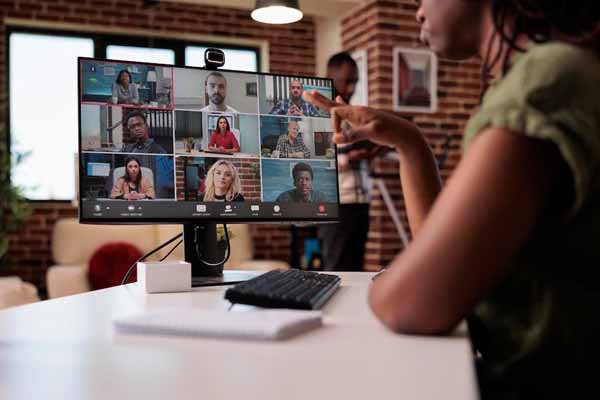How To Create A Consistent Company Culture In The Remote Setup Era With Sumit Singla
Distance changes things, there’s no denying that. But when it comes to running a business, being apart from each other must not negatively impact your company culture. In this episode, Sumit Singla showcases his more than 16 years of experience across multiple HR roles to discuss how to maintain strong bonds within your team despite the lack of face-to-face interactions. He discusses the strategies for implementing a consistent company culture in the age of remote setup and keeping business goals aligned with this model. Tune in now and learn how to cultivate trust and connections throughout your team across your screens!
—
How To Create A Consistent Company Culture In The Remote Setup Era With Sumit Singla
It is such a pleasure to have you all hopping on. With the holidays this 2022, it’s hard to stay on track. Sometimes commitments go out the window at this time of the year. We value that you took the time to hop on. It’s great to have you here. If you’ve never been to this show, and this is your first time, we want to welcome you and let you know what we do here. We bring a panel of hosts together each and every week. Our goal is to energize, elevate, and engage. That’s what we do here.
We want to help you, your companies, your organizations, and your businesses. We do that by bringing not just the panel of hosts but also a guest speaker. We cover all sorts of topics. If you have never been here before, we have a full archive. You can always go back. We have Sumit Singla with us. He’s not only our guest speaker but he’s a regular here on our panel. If you enjoy the session, be sure to come on back and hear what he has to say in other sessions as well. We are discussing everything to do with creating a consistent company culture in the era of remote work.
Let me take you back to the panel host and introduce you to everyone here. This is usually our full panel here. We’re missing a few people for the holidays. We will forgive them this time. We will let it slide. We do have Howard here. Howard is with Comp Team. He is a compensation advisor and strategist. He’s great with creating compensation software and helping companies transform in the areas of compensation. He has worked with big companies in the past, Citigroup and Barclays, to name a few.
We also have Sam, who is the Founder and CEO of Comp Team. Comp Team helps all sorts of companies transform their talent initiatives and compensation programs. He also brings us this forum each and every week. He helps find the speakers, brings everyone together, and creates all the slides. We also have Sumit Singla, who is our guest speaker and a regular here on our panel. You’re going to enjoy this topic.
He is so knowledgeable and very intelligent. He always has a lot of great opinions to share. He’s a people strategist with over eighteen years of experience working in different HR consulting roles. He specializes in HR transformation for companies. He specializes in diversity, equity, and inclusion. He’s going to have a lot of great opinions and thoughts on creating a consistent company culture in the era of remote work. Sumit, you know the drill. You know how things work around here. I’m going to pass things over to you.
Sumit, we went through a good background of your expertise and so forth, but we would love to dig in a little bit more and learn a little bit about how you got interested in management consulting, HR, people practices, and so forth. What started that spark in your career?
That’s an interesting question, Sam. Unfortunately, the answer is quite boring. It has been purely incidental. I started my career right after I graduated in Civil Engineering. This was in 2002. Civil engineers were not popular right then because of 9/11 and the fact that it was masterminded by a civil engineer. I ended up joining the BPO industry or Business Process Outsourcing.
I was part of tech support for Intuit’s backend services in India. That was my first brush with an American corporation and also working with a multi-geography workforce because customers were primarily North America-based. We had a workforce all over. Working with colleagues across the world and working remotely was a completely new thing to me. Somewhere down the line while training newer people, I developed an interest in training and HR.
To cut a long story short, I went back to school after having worked for about 5 or 6 years and came back into consulting because I realized I love solving problems. More often than not, the problems that a business faces can be solved by focusing on people. Every business I believe is a people business, whether you are into manufacturing, consulting, IT, or FinTech. They’re all people businesses at the heart of it. Therefore, that’s what sparked my interest in consulting. That’s what I’ve chosen as a career.
Your background is aligned with our conversation. When you first started, you worked in local or regional practice in India and then went to a multinational practice. The culture went localized to a global base where you’re talking to people on the phone. They’re distributed across the globe. How was that transition when you were going from working in a localized place to a global workforce?
It was interesting because you’re talking to somebody you’ve never met. I’m talking about years ago when technology wasn’t as great as it is now. You could barely hear people on the phone. Forget about being able to see them. Being able to solve problems for somebody who’s halfway around the world was incredible. It was simply brilliant to not have things like screen share but to have somebody describe what they’re seeing on the screen. You’re walking them through some steps to fix what they’re going through. Somehow being able to align and being on the same page was unbelievable.
The longest tech support call, which I took myself, was about fourteen hours. I was on the phone with one single person for about fourteen hours. It was crazy. It was maybe a couple of days before Christmas. They were trying to pay out their employees and struggling. We took lots of breaks in between. There were lots of small talks while some files were rebuilding and stuff but it was great to have that connection and find common ground with somebody so far away from you from a geographical standpoint.
If you are far away from somebody from a geographical standpoint, create a strong connection and find common ground with them. Share on XThings have changed now as far as technology and the remote environment. This is how fast things change. Being in America, GEICO is an insurance cover here. They’re famous for their commercials using this gecko. The skit on the commercial was about working remotely with a speaker phone and somebody interrupting you. You can’t hear them or things like this.
I was watching that commercial and thinking, “This is out of date now that we have been using Zoom for a period of 4 years or 5 years consistently.” There’s less chance of stepping on somebody that’s talking. We can see their face, so we know when they’re wanting to speak. A lot of those and even this commercial is out of date. It has only been 3 to 4 years since we have had this videocast or Zoom versus speaking on speaker phones. I wonder what’s next.
I’ve got a kid at home who refuses to have audio calls. If you are speaking to her, it’s video first. That’s the generation we are heading toward. There are no limits to what’s next.
That virtual presence is something that is possible. There has been technology out on that for over ten years now in some large corporate boardrooms and so forth. I do think that’s coming along, especially when we think about the metaverse and what that can bring if it ever rolls out appropriately. It’s meeting people more almost live face-to-face in that type of environment and moving around. That is something to be said. There have been growing pains in remote work and a lot of different things. What are the most common growing pains have you witnessed for companies in a struggle for their culture?
The biggest pain with remote work has been the element of trust. As a manager and as a leader, how do you make sure that what you expect should be done is being done when people are no longer in front of you? You no longer have the power to look over their shoulders to see how much they have done, what they have done, and whether somebody is watching Netflix when they should be working and stuff.

Company Culture: The biggest pain with remote work has been the element of trust. As a manager, you need to ensure that everyone is doing their job, even if they are no longer in front of you.
That has led to a whole lot of problems like installing spy software or forcing people to check in and be active on messengers. If you’re showing as Away on your office messenger, it means you’re slacking off. It has led to a whole new market of things like a mouse jiggler, which is a device that shakes your mouse every few minutes so that somebody thinks your computer has not gone up to sleep. The mistrust from both parties, employees and employers, is staggering. That’s one of the biggest challenges. There’s a trust deficit. It has grown during the era of remote work.
Does it require a mindset change from me as a manager actively seeing people with heads down versus, “I don’t care what your process is. I need to focus on results?” Is that what it takes?
I would say so, Howard, because when you’re trying to hold people accountable to outcomes, that’s always going to be better than saying, “I would like you to be in office for X number of hours.” People are always going to get around things like that. Many organizations are fond of recognizing people saying, “Sumit is so hardworking. I get emails at 2:00 AM from him on a regular basis.” The leader has no idea that Sumit knows this behavior is recognized.
He set up his outlook to schedule email delivery at 2:00 AM. He has been asleep for five hours when that email was sent out. Gaming the system is going to become more frequent. You’re doing the organization a disservice if you’re not training yourself to trust your employees and say, “Let’s agree on the outcomes. I don’t care if you work for four hours or the entire shift as long as we are delivering these particular results.”
That’s a good point because the lack of trust brings such wasteful administration and time spent. You’re talking about getting crafty about mouse jigglers, spyware, or scheduling to send emails off in crazy hours. All of that is silly and unproductive. It’s raising the game above that and making sure that we’re looking at our output. That was part of the response that a lot of managers and employees had during the pandemic in healthy organizations. As an employee, they’re saying, “I’m at home. I need to show that I’m doing my job. I want to make sure that I’m contributing and showing that.”
That led to a lot of high levels of production, perhaps some overwork, and maybe burnout in a lot of cases but that’s why we saw a spike in productivity. On the other side, managers were required to up their game as well. They were worried, “Are my people producing during this time?” They were required to have greater amounts of communication like reaching out and talking to people. For some organizations, that has helped their environment. Managers become more competent. For others, managers didn’t show up. As a result, people didn’t show up either.
We heard stories of people relocating or finding other jobs at the same time as they were working for a previous employer. On both sides of the scale, there are lessons to be learned there but other things with remote work have made us more resilient overall. There has been a lot of good manager training that has come out of this. There have been ways to make a drive toward a healthier workforce with more focus on well-being, “What is your health? If you’re not feeling good, don’t come into work.”
Companies are much more resilient and agile to be able to do that now that they have had a trial period of remote work, even if they’re requiring people to come into the office nowadays. A lot of positive things have come out of the past several years. We were talking about well-being. Some people still don’t know how to work remotely in a healthy way. Either they work too much or they’re lonely, and so forth. What are you seeing there, Sumit?
I largely agree with what you said, Sam. It also depends on what role the organization is playing in all these respects. The point about overwork and burnout that you made is real but it’s also created by employers who were telling people, “You had a two-hour commute per day. Now that I’ve allowed you or given you a perk called remote work, you might as well utilize those two hours in working. I would expect you to put in that extra time and devote it to work.” That’s ridiculous.
The loneliness angle that you mentioned is also coming in. Good companies are figuring out how to get around it and how to help people still form great bonds with their team members but in a command and control culture, these things are only going to get worse. You tend to play people against each other. They don’t have as much of a window to talk to each other. Some of these challenges exist. Good employers are learning to navigate around them.

Company Culture: Good companies are figuring out how to get around loneliness and help people form great bonds with their team members in a remote setup.
That’s why for some of the best-in-class organizations, employee engagement has gone up post-pandemic. They’re seeing more people being retained and more people being grateful for the fact that there’s an investment in well-being but at the same time, we have got some significant distance to cover. One of the big four consulting firms announced their best year ever, but they announced among the lowest bonuses to be paid out to employees. It doesn’t make sense at all.
I’m having that misalignment. That needs to be explained.
Howard wrote into the chat, “If any of your companies are providing training to managers as to how to effectively manage remote teams.”
I was posting that for the people participating. Sumit, you do a lot of research on training. Are you finding that companies are now stepping up and providing training programs for managers?
It’s more a case of winging it and figuring things out as we go, especially because I don’t believe anyone has figured out the key to what exactly is an effective remote team. How do I make the team more effective? In a nutshell, my advice would be to get out of the team’s way. You will have an effective team but I would say the same for an in-person or in-office team as well.
In a game of football, as a manager, you would shout out instructions and give people feedback. You wouldn’t jump in and start handling the ball for them. You’re getting in the way. You would be slowing them down. You will get kicked out by the referee as well. That’s a different story but the fact is that you need to be an enabler rather than a disruptor. The same goes for a remote team as well. As a manager, your role is to create the right culture. Your role is to act as a buffer and absorb the extra pressure that people are feeling. Get rid of things like overwork, loneliness, burnout, and all the negative things that we spoke about. You will have a winning team on your hands.
What about new team members? Much of how I grew up in the workforce was the day-to-day interaction among the team. It’s hard to replicate that over Zoom calls. How do you start creating those connections and bonds when everyone is remote?
It will remain a challenge, especially for the newer team members but have things like what Microsoft does. They’ve got virtual water coolers. They’re trying to replicate the idea of checking in on a coworker or dropping in where you set up a random time for people to catch up. I discovered this by being an independent worker myself. There are different communities where you can log on and co-work at the same time.
You’re on camera. You’re virtually co-working where you log on, say hi to each other, and talk about what are your expectations to achieve during this day. You put yourself on mute and get back to work. You take scheduled breaks and chit-chat about how is the weather. Let’s say your pet cat or dog walks by. You introduce them to the rest of the gang and so forth. Those are icebreakers that people are learning to create during the pace of remote work as well. It does help.
That’s interesting, Sumit. It reminded me of a thing that we recommended for our client a number of years ago. This was way before the pandemic or remote work craze that we have been going through. This client had multiple locations across the globe. They’re having problems with these different cultures popping up in different locations. Their Iowa location had a different culture than the culture in California. It’s significantly different from where they were doing business differently and so forth. They didn’t have shared values. One of the initiatives that they were doing is being better with communication, sharing those values, and adopting them in their hiring practices and so forth.
One thing also that was fun that we recommended is putting a live screen or a video feed in their break rooms. As you walk into a break room, you would also visit the break room in your different locations. You would have a video screen of the California break room and another one in the Iowa break room. You could see people getting coffee at the same time and having actual chats. They would have chats across those different locations as they bumped into people. It turned into a fun thing. That’s something that I haven’t thought about in a while that you helped popped into my mind there, Sumit.
That’s a great idea. I can see how it would be useful in the current context as well.
I like the idea if you have that loneliness factor to be able to go into a shared co-working space, even if it’s remote with colleagues. Are these established businesses or clubs that you can recommend? Where did you find these places, Sumit?
There are different things that you can do. I believe it’s one of the IT companies that have this concept of giving people small travel stipends for them to work from co-working spaces. If there’s a sizable chunk of the population in a particular city, they’re giving them some incentive to get together on a couple of days in a week or a month and work from a co-working space.
There are lots of communities for freelancers and independent workers to get together. Have a Slack channel where you could talk about a new article you’ve written on LinkedIn and have a plug for your services. It could be a mental well-being channel where you’re talking about how you’re feeling on a particular day, sharing some little wins and some frustrations, and being there as a community to support each other. Larger tech companies like Adobe and Microsoft are also taking their employee support groups to these channels so that people can find the right help and support.
Here’s one thing that we should keep in mind in all of this when we’re looking at the traditional work environment where we are meeting face-to-face with our colleagues. There has been the rise of co-working where we’re meeting with other professionals in a similar or shared environment and then also in the fully remote environment where we might be meeting people across the globe that we haven’t worked with before. The common theme in all of this is that, unlike the traditional work environment, we’re meeting with colleagues.
We have the opportunity now in a remote environment to meet with multiple different people, not just our colleagues during the workday. If you think about expanding this and not being lonely, you can also communicate with your neighbors and so forth. You can get coffee at the same time or have lunch with friends or family and things like this. It doesn’t have to be surrounding the workforce.
There’s a bookstore that I regularly buy books from. They have moved into hosting different kinds of events. They’re asking me to conduct an event, talking about some of the best books I’ve read over the years. They’re inviting people in. They hold regular book discussion events and so on. It’s a great way to meet people who are not colleagues but who share the same passion. There are all kinds of clubs. You could have a club for people who like a particular brand of stationery. Such clubs do exist. I’ve come across them. It’s all about finding the common ground and being able to form those bonds, which is something that companies can learn from and use these techniques to take the culture online.

Company Culture: Every company must learn to find common ground and form strong bonds within the team if they plan to take their culture online.
Another thing that I would like to bring up in the remote environment is that it has been easier for companies to dive more into diversity, equity, and inclusion when we’re thinking about opening up. We’re not dealing with a small location around our town or where we’re doing our business but we can now have involved communities that are outside our own, whether they may be in other countries such as, in this very case, India. Howard is in New York. I’m in Colorado. Jules is a Native Australian who is in LA. There’s a diversity that can take place. That has been another thing of beauty in the remote environment. How have you seen companies embrace this diversity in the remote world, Sumit?
It’s a mixed bag. The great thing is to be able to have people from different backgrounds and geographical areas together but you need to be sensitive to the time zone differences. If you’ve got somebody from Australia, India, and the US, it’s complicated because there could be a 16 or 18-hour time zone gap in all three locations. Finding a time that works for all of the individuals could be difficult. You also have to accommodate some of their life-stage challenges. It might be bedtime for somebody’s toddler. It could be time to prepare breakfast for somebody’s partner. It could be time to provide medication to somebody you’re a caregiver to.
Lots of personal priorities would need to be addressed. The other important thing is this. Are we able to accommodate different personality types and be inclusive? Somebody who’s an introvert may not want to have their camera switched on at all times. They might be more comfortable talking off camera, not being stared down by ten odd people in a meeting. Somebody who’s neurodivergent might be more comfortable with email or Slack instead of being put on the spot saying, “Do you have an opinion?” We need to do a lot more work on being inclusive. The great thing is remote work and the pandemic at least got us started on some part of the journey.
Companies need to do a lot more work on being inclusive. Share on XI have a great tool for the time zones. I don’t know if you know the World Meeting Planner. Have you used that website before?
I use one called Time Buddy.
Maybe it’s similar. It’s WorldTimeServer.com. You can put in different cities. You have a time in mind. Let’s say you’re in India. At 9:00 AM, you want a meeting. You can type in the other cities that you want to figure out what time it would be there. It makes things so easy to be like, “If it’s 9:00 AM in India, it’s going to be 3:00 PM in some other city.” It takes all the guesswork of, “They’re nine hours ahead.” I type it all into that website. It has a nice grid, which is helpful. It’s a great tool if anyone has never used it before. I wanted to throw that in there.
That’s interesting. It seems to work quite similarly to Time Buddy. This one gives a broader range of times. It might be a good overlap. I remember using this one. It does give a red, amber, and green analysis. It marks times when a person might be sleeping as red saying, “2:00 AM is maybe not a great idea for a meeting.”
That’s handy too. It’s got the color grading. Time Buddy as well.
I imagine there are other apps too that probably have now picked up in terms of usage in terms of project management, coordination, and storage because you have to make sure you have those things standardized and stuff, “I’ve worked on a file. Where is it going? Who is going to pick it up?” Have you seen things like that, Sumit?
Things like Monday.com and ClickUp are doing well because the asynchronous part of communication can be done so well. During your waking hours, you could leave a note for me saying, “Where’s this file you might need for a client meeting?” When my workday begins, I see that note and attach the file. The very next morning, it’s right there for you. Managing projects and client deliverables and communicating with each other is better than email in that sense and a lot more effective and efficient.
Some of the challenges working remotely too are technology and weather conditions.
It’s so seamless.
We were talking about some of the tools that we need to rely on and use to keep people on track and coordinate work that’s being done. We were talking about Slack and Monday.com.
That brings up another good point on keeping people on track, setting goals, KPIs, and so forth, and driving towards those. These tools can help us be mindful of not just projects and communication but also we all have suffered. If you’re not seeing a person on a daily basis, you might forget them or forget where they are in certain pieces. What about their career advancement? Are we treating them fairly with promotions, learning opportunities, and things like this? Systems can help us stay more on track and be more responsible all around for sure. Have there been any developments in goals or goal management in the remote environment?
Honestly, overall, goal-setting has been one of the weakest elements of managing performance even before the remote work era but companies are evolving and becoming a lot more outcome-oriented rather than clocking in a certain number of hours. The goal-setting element has become an area of focus. There are managers who are actively trying to improve on it because it’s the need of the hour.
Companies are evolving to become a lot more outcome-oriented in measuring individual performance. They don't simply check if people are clocking in a certain number of hours. Share on XSince you can’t keep hovering around a person and checking in on them regularly, it has become critical to agree on the outcomes they’re going to deliver and then make sure they’ve got the right resources. As a manager, you can’t shy away from your responsibility anymore. The onus is anew to make sure your team member has the right tools and support to attain or achieve those goals. Otherwise, you are the one who’s failing in their duty.
It has also helped managers hone their processes because as we’re looking at bringing on people that are remote, tracking projects from a remote standpoint and goal-setting, it makes us think about how we go through the process of getting things done. When we were in the office, we could sit down and walk somebody through a process. It’s pretty easy to do when you’re face-to-face, “Do what I do.” We have to be much more organized in a remote environment. This helps advance companies forward to doing things consistently, documenting processes, procedures, and goals effectively, and being better with communication. It’s not something that we should shy away from.
As we have seen in the past, there has been a trend, “The pandemic has gone on for some time. Now, it has worked into the flu season and everything else. It’s not going away anytime soon. Let’s all get back in the office.” There are a lot of companies that have gone to that extent and have given up on the remote world but that comes to a disservice in a lot of ways. There’s something to be said for a hybrid environment, allowing flexibility. You can attract and retain a much more diversified and highly talented workforce as a result. A big part of this is documenting those procedures, processes, and goals. We’re expecting more for our managers in this process to up their game.
Earlier, you could rely on an old timer to act as Gandalf figure walking a young newbie through the way we do things around here, “Let me show you all the office artifacts, what we do during our break times, and how exactly we manage our schedules.” Unless it’s documented, that knowledge will be lost forever. Your culture and all the norms, beliefs, and attitudes need to be written down somewhere or a new person to be able to assimilate them. Otherwise, you will find your culture transforming with every wave of new people that are coming in. We will find ourselves losing a sense of cultures that we are proud of. Documentation is critical.
What other areas of culture do you see as being very important in the remote world? We have talked about a few things such as making sure that we’re collaborating and communicating effectively. We talked a little bit about diversity, equity, and inclusion. We touched on well-being a bit and some factors. What are you seeing overall? What are the big cultural things that we need to be concerned about?
Well-being is a larger umbrella that needs to be broken down into sub-components like the physical well-being part of it. It isn’t enough to offer people the flexibility to work from anywhere. Are you ensuring that they’ve got the right office ergonomics set up? Are you providing them support to make sure they’ve got a comfortable and safe desk and a good chair? Do you have any allowances for that?
Well-being is a larger umbrella that needs to be broken down into sub-components. It isn't enough to just offer people the flexibility to work from anywhere. Share on XFor example, companies like GE have certified experts who evaluate your posture. They look at your chair. They do it all on video but they help you in evaluating whether you’re setting yourself up for long-term injury by working from home. That’s phenomenal. It’s a great value-add to an employee. It also makes you feel cared for that the organization is not just looking at you as a person occupying a chair. They’re concerned about your well-being. That’s on the physical well-being part of it. You can make taking a certain amount of breaks mandatory and say, “I don’t want to see you eating at your desk.”
In mental well-being, the conversation has moved on from training people to giving them the right tools to be able to focus on their priorities. In companies like Accenture, people are encouraged to put a photo on email saying, “I’m sending you this email at a time that’s convenient to me. Please don’t feel pressurized to respond to it the moment it drops into your inbox,” or something of that sort. They’re trying to encourage people that just because they’ve seen an email does not necessarily mean they’ve got to respond to it right then and there.
A big thing that has happened during the pandemic is financial well-being where there’s a lot more uncertainty about whether you would be able to cater to any urgent requirement in case of an emergency. By providing solutions like on-demand pay or low-cost or no-cost loans, companies are trying to step in and help their people. In addition, things like counseling, debt restructuring sessions, along with sessions on how to maximize your earning potential by making the most of things like stock purchase plans are helping people in saving more money. They’re also helping people in earning more money. That’s responsible.

Company Culture: Companies are stepping in to try and help their people by providing solutions like on-demand pay, low-cost, or no-cost loans.
The other thing that is quite important for companies is to continue to innovate. We went through a forced innovation because of the remote work phase due to the pandemic. We saw how fast we could adapt and move forward. There are other things that are coming forth in the economy. In the United States, we’re dealing with a potential recession. We have been talking about it for quite some time. Some say that we’re in it already and others say that the worst is yet to come.
We need to continue to make our businesses more agile and resilient to weather those pieces, whether it’s economic or another calamity that we went through. The other piece of being more resilient is thinking about being more resilient with our workforce. There are many different ways of working nowadays. There are full-time and part-time employees, gig workers, freelancers, consultants, and contractors. There are tons of different things. The contingency workforce is quite large.
Jules comes from a place in Australia where the contingency workforce is almost half or if not half the population by now. People have a lot of different ways that they show up for work. The important thing is that when we’re designing the workforce of the future, we need to make sure that we take all these different pieces into consideration and also start thinking out of the box. We’re used to thinking about employees but there are so many other types of workers that are driving results to the organization and deserve to be treated in a fair way or in a way that’s in alignment with our overall workforce as a whole. How we think about the workforce needs to change.
There are also other aspects. We went through the remote work transformation. What’s the next transformation that we can provide as far as work flexibility? Is that going to be perhaps the four-day workweek, the flexible Fridays in the summers, or whatever makes sense for your demographic? The important thing is for us to continue to innovate and move forward. One important thing that was found or discovered during this process is that productivity is not as time-based as we once thought it was. Productivity is something flexible.
There are some organizations that have found that they can get as much done in 4 days that they once were doing in 5 days. The lesson to be learned there is let’s reward that time back to our people. If we’re going to be able to measure good performance and productivity effectively in our organizations, then let’s reward our people with that increased performance in the success of the company and be an even better place to work in the future. There are a lot of good things to think about.
One could break it down into three aspects and say that the future could be divided into the future of work, the future of the workplace, and the future of the workers. By nature, work and jobs are evolving. Years ago, jobs like Uber driver, data scientist, and all of them didn’t exist. Even things like content marketing or digital marketing did not exist. We have had a spade of new jobs. That’s going to continue. What are the new skills and rules that we can aspire towards?
There already are people thinking about how to best utilize the skills of an aging demographic as well. That’s why countries like China have special universities for senior citizens or people who are above 60 years of age to give them advanced skills so that they can continue being productive until they’re about 75 or 80 years old. If they want to work, they can. That’s how the future of work and workers is changing.
We’ve got AI and robots working alongside us. How do we function better? How do we use our gray cells for more intellectual work and leave technology to do the more repetitive or rapid computing things? Workplaces have shifted because of the pandemic. There’s the overnight transformation from in-person and in-office work to remote but even before that, thanks to technology, there has been a change that has not been talked about as much.
One of the industries that have been at the forefront of digital transformation is automotive. There are companies that have been 3D printing different automotive parts. You’re located in a remote region. You need a spare part. It’s prohibitively expensive to ship it across to you from wherever it’s being manufactured. Therefore, there’s a 3D printer a couple of hundred miles from you. Print that component and send it across to you. Technically, that is remote manufacturing. Your auto component is not being manufactured in a factory. It’s being manufactured much closer to where the end customer is.
That’s great. We need to think of those things. I know that a lot of you out there have been going through a wonderful holiday season. I’m bracing for a lot of weather where I’m at. I hope everybody is staying safe out there and across the different storms that they might be experiencing. Here’s a special shout-out and thank you to Sumit for joining us and talking about the evolution of remote work and what are the things to come for 2023 and so forth. Thank you, Sumit.
Thank you.
Important Links
- Sumit Singla – LinkedIn
- Slack
- World Meeting Planner
- Time Buddy
- WorldTimeServer.com
- Monday.com
- ClickUp
About Sumit Singla
 Sumit has been working in HR & HR consulting roles for 16+ years across sectors and verticals and specializes in organizational design, well-being, storytelling & design thinking, and performance management. In his career with consulting firms such as Aon, Deloitte, and Accenture, he has successfully led programs aimed at total HR transformation for clients.
Sumit has been working in HR & HR consulting roles for 16+ years across sectors and verticals and specializes in organizational design, well-being, storytelling & design thinking, and performance management. In his career with consulting firms such as Aon, Deloitte, and Accenture, he has successfully led programs aimed at total HR transformation for clients.
As Associate Director for India Consulting at Deloitte, he recently worked with clients on cultural transformation, HR processes, and policy design. He also organized and spoke at conferences and events about various topics relevant to HR today.
Now self-employed, he works with clients across the globe on various HR solution areas.




